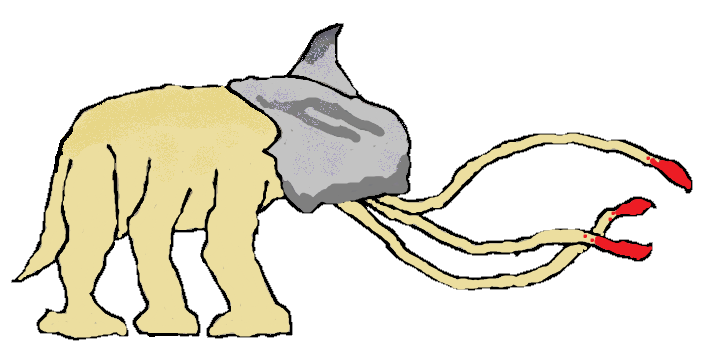Shredder
Along with the Sand walker, this is probably the largest omnivore on the planet. It's bulk of five tons roams the desert, searching for food. While they do sometimes group up for protection, they are often seen alone.
Basic Information
Anatomy
This six legged beast is not like anything from earth. It is twelve feet tall at the shoulder, and has a large helmet. In this helmet, it stores tentacles, which it uses as food collection and defense. Each tentacle is elastic, being able to stretch up to forty feet long. When in danger, they lay their head down on the ground, and shoot all seven tentacles out through the sand. They then wrap around the predator/rival, and pulls them down into the sand if possible. If the enemy is killed, the shredder is happy to eat it afterwards. They have no remorse.
Biological Traits
Large helmet, used to bash and ram enemies. They are a standard seisopod, a creature with six legs, and are quite adapted to their environment.
Genetics and Reproduction
While there don't seem to be any true genders, in order to breed, there needs to be a pair. To court, they go through a 'dance' so to say, where the rear up on the back legs, and slam down again. This process can take hours. Once done with the dance, they mate similarly to the Sand walkers. Gestation takes roughly a year, then a small baby is produced at the end of the dry season.
From birth, they are on their own.
Growth Rate & Stages
A newborn shredder will be much smaller than an adult, as to be expected. They also don't have as well developed of a helmet as the adults. They don't need much food, but commonly will eat to near bursting, in the desert, you never know when food will come again. The time from birth to adulthood takes six to seven years.
Ecology and Habitats
While they are just as adapted to the desert as the sand walker, they accomplished this in a very different way. While the sand walker took a long legged, fast if needed route, the shredder chose to be a natural tank. Nothing except another shredder attacks an adult shredder. The optimal environment for this creature is a sandy desert. Although they seem to have some digging capabilities, they mainly keep to the surface.
Dietary Needs and Habits
While they aren't the fastest animal, they can go months without eating, if they had a good meal. Inside their helmet, along with the tentacles, is a large, beak-like mouth. It is used to crush any skeletal structure or tough flesh they might try to eat. If they can't find food, they actually may try to eat themselves out of hunger, a strange, but, surprisingly effective tactic.
Biological Cycle
Every two years as an adult, they need to shed their helmet. It is a long process, and one which is not taken lightly. These usually tough and fearless animals become cowardly at losing their main defense. While it does take quite a bit to accomplish, a new, bigger helmet waits under neath, often with larger horns or pattern changes.
Additional Information
Social Structure
They are only seen alone, so much so, in fact, outside the breeding season, they will greedily kill and eat any passing shredder.
Domestication
It has actually been accomplished, before. They are mainly used to pull large trade wagons, but they are sometimes used for guard animals.
Facial characteristics
Their helmet is similar in texture, color and shape to a large boulder. Their horn is used for territory disputes and defending against adversaries.
Geographic Origin and Distribution
Around the Crystal sands, but a few have been reported in the Eastern forests.
Average Intelligence
Low, although they do seem to have some degree of planning capabilities.
Perception and Sensory Capabilities
Like most of the desert creatures on the continent, they have no eyes. Instead, they use echolocation, like a bat or whale. The tentacles are also used to investigate unknown objects. The helmet also acts as a amplifier, making their calls louder.
Scientific Name
Harena Magnus
Origin/Ancestry
Was developed in the desert from the beginning
Lifespan
Up to sixty years, if they survive attacks from adults
Conservation Status
While they are rarer than Sand walkers, they are their own downfall. There seems to be a limit of adult shredders that can exist. If it is exceeded, large adults single out the smaller individuals.
Average Height
12 feet
Average Weight
3-4 tons
Average Length
Usually 24 feet
Average Physique
Large, but not bulky
Body Tint, Colouring and Marking
Their bodies are tan, with slightly darker striping. Their helmet is mainly grey, but a few have been seen with blue, black and even white helmets!
Remove these ads. Join the Worldbuilders Guild









Comments